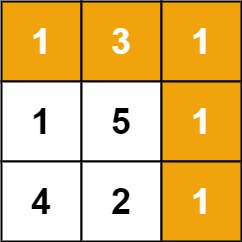LeetCode-in-All
64. Minimum Path Sum
Medium
Given a m x n grid filled with non-negative numbers, find a path from top left to bottom right, which minimizes the sum of all numbers along its path.
Note: You can only move either down or right at any point in time.
Example 1:

Input: grid = [[1,3,1],[1,5,1],[4,2,1]]
Output: 7
Explanation: Because the path 1 → 3 → 1 → 1 → 1 minimizes the sum.
Example 2:
Input: grid = [[1,2,3],[4,5,6]]
Output: 12
Constraints:
m == grid.lengthn == grid[i].length1 <= m, n <= 2000 <= grid[i][j] <= 100
To solve the “Minimum Path Sum” problem in Swift with the Solution class, follow these steps:
- Define a method
minPathSumin theSolutionclass that takes a 2D grid of non-negative numbers as input and returns the minimum sum of all numbers along the path from the top-left corner to the bottom-right corner of the grid. - Initialize a 2D array
dpof sizem x n, wheredp[i][j]represents the minimum sum of the path from the top-left corner to position(i, j)in the grid. - Initialize
dp[0][0]to the value of the top-left cell in the grid. - Initialize the first row and first column of
dpbased on the grid values and the previous cells in the same row or column. - Iterate over each position
(i, j)in the grid, starting from the second row and second column:- Update
dp[i][j]by adding the current grid value at(i, j)to the minimum of the values of the previous cells(i-1, j)and(i, j-1)indp.
- Update
- Return
dp[m-1][n-1], which represents the minimum path sum from the top-left corner to the bottom-right corner of the grid.
Here’s the implementation of the minPathSum method in Swift:
class Solution {
func minPathSum(_ grid: [[Int]]) -> Int {
var matrix: [[Int]] = grid
let n = grid.count - 1
let m = grid[0].count - 1
for i in 0...n {
for j in 0...m {
var step = matrix[i][j]
if i > 0 && j > 0 {
step += min(matrix[i - 1][j], matrix[i][j - 1])
} else if i > 0 && j == 0 {
step += matrix[i - 1][j]
} else if j > 0 && i == 0 {
step += matrix[i][j - 1]
}
matrix[i][j] = step
}
}
return matrix[n][m]
}
}
This implementation efficiently calculates the minimum path sum using dynamic programming, with a time complexity of O(m * n) and a space complexity of O(m * n).

